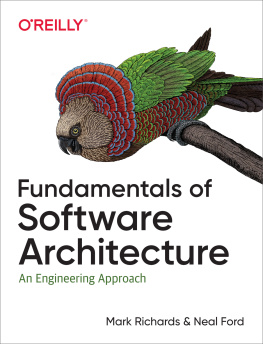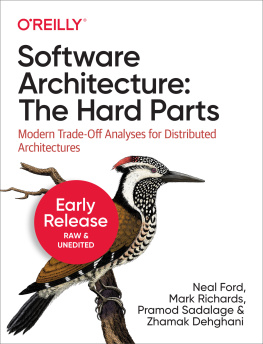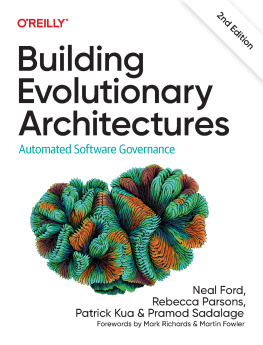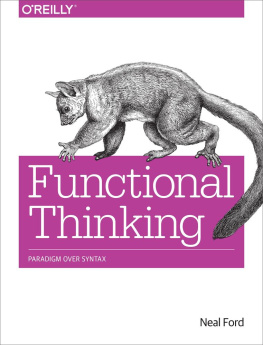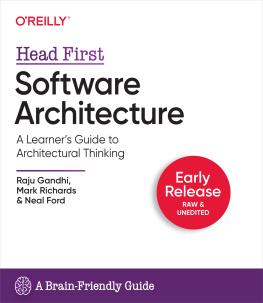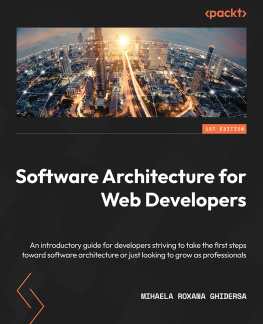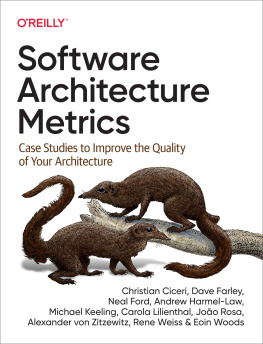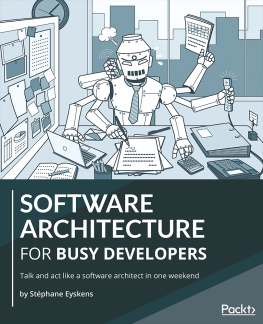Praise for Fundamentals of Software Architecture
Neal and Mark arent just outstanding software architects; they are also exceptional teachers. With Fundamentals of Software Architecture, they have managed to condense the sprawling topic of architecture into a concise work that reflects their decades of experience. Whether youre new to the role or youve been a practicing architect for many years, this book will help you be better at your job. I only wish theyd written this earlier in my career.
Nathaniel Schutta, Architect as a Service, ntschutta.io
Mark and Neal set out to achieve a formidable goalto elucidate the many, layered fundamentals required to excel in software architectureand they completed their quest. The software architecture field continuously evolves, and the role requires a daunting breadth and depth of knowledge and skills. This book will serve as a guide for many as they navigate their journey to software architecture mastery.
Rebecca J. Parsons, CTO, ThoughtWorks
Mark and Neal truly capture real world advice for technologists to drive architecture excellence. They achieve this by identifying common architecture characteristics and the trade-offs that are necessary to drive success.
Cassie Shum, Technical Director, ThoughtWorks
Fundamentals of Software Architecture
by Mark Richards and Neal Ford
Copyright 2020 Mark Richards, Neal Ford. All rights reserved.
Printed in the United States of America.
Published by OReilly Media, Inc. , 1005 Gravenstein Highway North, Sebastopol, CA 95472.
OReilly books may be purchased for educational, business, or sales promotional use. Online editions are also available for most titles (http://oreilly.com). For more information, contact our corporate/institutional sales department: 800-998-9938 or corporate@oreilly.com .
- Acquisitions Editor: Chris Guzikowski
- Development Editors: Alicia Young and Virginia Wilson
- Production Editor: Christopher Faucher
- Copyeditor: Sonia Saruba
- Proofreader: Amanda Kersey
- Indexer: Ellen Troutman-Zaig
- Interior Designer: David Futato
- Cover Designer: Karen Montgomery
- Illustrator: Rebecca Demarest
- February 2020: First Edition
Revision History for the First Edition
- 2020-01-27: First Release
See http://oreilly.com/catalog/errata.csp?isbn=9781492043454 for release details.
The OReilly logo is a registered trademark of OReilly Media, Inc. Fundamentals of Software Architecture, the cover image, and related trade dress are trademarks of OReilly Media, Inc.
The views expressed in this work are those of the authors, and do not represent the publishers views. While the publisher and the authors have used good faith efforts to ensure that the information and instructions contained in this work are accurate, the publisher and the authors disclaim all responsibility for errors or omissions, including without limitation responsibility for damages resulting from the use of or reliance on this work. Use of the information and instructions contained in this work is at your own risk. If any code samples or other technology this work contains or describes is subject to open source licenses or the intellectual property rights of others, it is your responsibility to ensure that your use thereof complies with such licenses and/or rights.
978-1-492-04345-4
[LSI]
Preface: Invalidating Axioms
Axiom
A statement or proposition which is regarded as being established, accepted, or self-evidently true.
Mathematicians create theories based on axioms, assumptions for things indisputably true. Software architects also build theories atop axioms, but the software world is, well, softer than mathematics: fundamental things continue to change at a rapid pace, including the axioms we base our theories upon.
The software development ecosystem exists in a constant state of dynamic equilibrium: while it exists in a balanced state at any given point in time, it exhibits dynamic behavior over the long term. A great modern example of the nature of this ecosystem follows the ascension of containerization and the attendant changes: tools like Kubernetes didnt exist a decade ago, yet now entire software conferences exist to service its users. The software ecosystem changes chaotically: one small change causes another small change; when repeated hundreds of times, it generates a new ecosystem.
Architects have an important responsibility to question assumptions and axioms left over from previous eras. Many of the books about software architecture were written in an era that only barely resembles the current world. In fact, the authors believe that we must question fundamental axioms on a regular basis, in light of improved engineering practices, operational ecosystems, software development processeseverything that makes up the messy, dynamic equilibrium where architects and developers work each day.
Careful observers of software architecture over time witnessed an evolution of capabilities. Starting with the engineering practices of Extreme Programming, continuing with Continuous Delivery, the DevOps revolution, microservices, containerization, and now cloud-based resources, all of these innovations led to new capabilities and trade-offs. As capabilities changed, so did architects perspectives on the industry. For many years, the tongue-in-cheek definition of software architecture was the stuff thats hard to change later. Later, the microservices architecture style appeared, where change is a first-class design consideration.
Each new era requires new practices, tools, measurements, patterns, and a host of other changes. This book looks at software architecture in modern light, taking into account all the innovations from the last decade, along with some new metrics and measures suited to todays new structures and perspectives.
The subtitle of our book is An Engineering Approach. Developers have long wished to change software development from a craft, where skilled artisans can create one-off works, to an engineering discipline, which implies repeatability, rigor, and effective analysis. While software engineering still lags behind other types of engineering disciplines by many orders of magnitude (to be fair, software is a very young discipline compared to most other types of engineering), architects have made huge improvements, which well discuss. In particular, modern Agile engineering practices have allowed great strides in the types of systems that architects design.
We also address the critically important issue of trade-off analysis. As a software developer, its easy to become enamored with a particular technology or approach. But architects must always soberly assess the good, bad, and ugly of every choice, and virtually nothing in the real world offers convenient binary choiceseverything is a trade-off. Given this pragmatic perspective, we strive to eliminate value judgments about technology and instead focus on analyzing trade-offs to equip our readers with an analytic eye toward technology choices.
This book wont make someone a software architecture overnightits a nuanced field with many facets. We want to provide existing and burgeoning architects a good modern overview of software architecture and its many aspects, from structure to soft skills. While this book covers well-known patterns, we take a new approach, leaning on lessons learned, tools, engineering practices, and other input. We take many existing axioms in software architecture and rethink them in light of the current ecosystem, and design architectures, taking the modern landscape into account.

